In Iceland, there's a saying: "If you don't like the weather, wait five minutes." It's a joke about the nation's harsh, volatile climate, and it's a profession of faith. Even when you're caught in sideways rain and are miles from shelter, you can find comfort in the idea that the weather might get better in just five minutes. And that's true; it might. You just can't know whether it will.
Green Mountain Majesty
When I was at Kirkjufellsfoss, the sky was perfectly sunny and clear. This place is quintessentially Iceland — a waterfall in the foreground of an alien-looking, lush mountain that was carved out by a glacier, on the coast of the Arctic.1 The view from Kirkjufellsfoss is the most beautiful thing you can see (from the roadside) on the Snæfellsnes Peninsula, which is why there's a parking lot big enough to accommodate ten tour buses at any one time. When I was there, the place was flooded with hurried ants trying to clip off a piece of the view to take back home. There was a guy kneeling down by the sign that read "No Drones," setting up his drone. There was a young couple blocking the path to the parking lot, taking timer-selfies with a tripod. Another guy stepped over the rope that marked the footpath to stand on a rock in the stream beneath the waterfall, to get a picture without any pesky people in the background. I was the only one who had walked there and the only one who would walk from there. I was the only one that had nowhere else to be, so I stayed until three bus-fulls of tourists had left. I picked a spot with a nice view and stood still, trying to appreciate Her Majesty, Nature.
This was Day 19 of my summer in Iceland, and I was in the middle of my second through-hike, this one in Snæfellsnes. It's a long, thin peninsula in the West known as "Iceland in Miniature," because it has all the geological features of the nation: a glacier, volcanos, mossy lava fields, mountains, beaches, and crazy rock formations. Snæfellsnes is a microcosm of Iceland's landscape, and I spent a week hiking through it all.
After Kirkjufellsfoss, I hiked out of the valley alongside the road that ran up and around the fjord, away from Grudarfjordur. Behind me was Kirkjufell, which shrank in the distance. To my left were other majestic mountains, ones that the tour-bus ants were too busy to consume. Nestled deep in those mountains were waterfalls that you'd miss in a blink if you were driving by. But walking, you can spend fifteen minutes admiring the tall, distant waterfall before it disappears behind a cliff again.
On the other side of the fjord, I had a perfect, unobstructed view of Snæfellsjökull, the volcano-glacier at the tip of the Snæfellsnes Peninsula, and the portal to the center of the Earth.2 Between me and Ólafsvík, my destination, was a two-mile black sand beach. I hiked down from the road and walked barefoot for the full length of the beach. It was wide and had little hills of sand and grass on one side, so I couldn't hear or see the cars on the road. And on the other side, it was just ocean to the horizon — 300 miles beyond that, Greenland. It felt like I'd been transported to a different place in space or in time, a place or time where humans didn't exist, and I was brought there to observe it for a moment, like a dream.
There were smooth pebbles scattered in a line along the shore. I walked on them and massaged the nerves in my heels — Nature's remedy. The only thing to disrupt my peace was a pair of pissed-off Arctic terns. If you come near the nesting sites of these birds, they'll take to the sky and start dive-bombing toward your head, as if they're going to rip it off and stick it on a pike to deter any other humans who would dare come near their young. These birds have two types of squawks. One is a normal bird-sound, just more frequent and more annoying. The other haunts me. It's a short, raspy growl, and it's the closest thing to a bird yelling "Fuck off!" But in that moment on that beach, I found a rare bliss, and the terns ceased to bother me. In fact, I included them in my thoughts as I paused to revel in Nature's majesty.
When you're living in Iceland — especially when you're living outdoors — you're always grateful when good weather lasts more than five minutes. On this day, it was perfect for my whole hike. After 15 miles, I arrived in the beautiful Ólafsvík and met a kind couple who were roadtripping. I mentioned that I'd been eating my oatmeal with hot sauce, and they gave me their extra brown sugar. I showered in geothermally heated water, in the nicest shower of any campsite yet, and fell asleep after this perfect-weather day, assuming it would be just as nice the next day.
Irrepressible Thoughts of Dying
The next morning, I said goodbye to the kind brown-sugar couple and told them I'd be hiking up and over the mountain near the glacier. They wished me well and warned me about a storm coming in, before riding away on hatchback. I've spent entire days hiking in the rain. I'm not worried about a storm — no way I'll let this mess up my itinerary. Without checking the forecast or reading any headlines of the local news (which is also the national news), I set out from the Ólafsfík campsite at 11:00 am.
It was overcast with a light breeze — nothing that I, a now-seasoned backpacker, couldn't handle. Five minutes later (almost exactly), waves kicked up that would be too gnarly for even the most radical dude you could find at Huntington Beach. If vertical, the winds would have suspended me in the air like a skydiving simulation. But they were sideways, and the dark clouds had broken, meaning that there was terminal-velocity wind hucking water orthogonally at my face. I wish it had been straight hail rather than sideways rain. I took cover behind a large, metal shed in the back of a fishing yard. (Thankfully, I was upwind of the lot full of the week's catches, not just for the smell but for the very real danger of a scaly carcass flying off the top of an open storage bin and knocking me unconscious.) If this storm had happened overnight, the wind would have lifted my six-foot by two-foot tent into the sky and whisked me back to Kansas (a reverse-Dorothy). I stayed behind the corner of the metal shed for at least five minutes, thinking the crazy storm might pass. Then, another five minutes, and another. It was time to make a move.
I needed to get back to the campsite and wait this out inside. Once there was a dead moment in the wind, I ran down the hill from the shed toward the road, ducking behind a concrete-reinforced, double-pane picket fence. I thought about walking the half-mile back to the campsite, and then I thought about how close I was just then to being blown over by the wind. Instead, I stuck out my thumb.
Three cars came by within fifteen minutes or so, and the third stopped for me (also probably the first to see me, since I was huddled up by the fence, away from the road). The passenger door flew open when I pulled the handle. I was worried I'd broken it, and it took a mighty yank to shut it against the wind. This nice guy drove me half a mile and dropped me off at the campsite, and I took shelter in the kitchen for the next few hours. In this case, the bad weather lasted closer to five hours than five minutes.
I didn't see sunshine until after 3:00, which is when I decided to try the hike again. It was calm — no clouds, no sideways rain — and I began the 2,000' ascent up the interior road F570 toward Snæfellsjökull. I noticed a downed sign that read "Impassable" and propped it back up. Maybe for a car but not for me. Nothing is impassable for me.

This easy hiking lasted about a hundred vertical feet. It turned out that the morning's crazy storm had just moved up the mountain. I then faced the same winds but less rain, and I was walking up the steep road with the weather working directly against me. Within a minute of those high winds, I was as soaked as I had been in the morning. Wet pants plus high winds also means I was cold. For little respites, I knelt behind or sat against big rocks beside the road, just to muster enough energy to continue. Two cars passed me and then turned around to head back down the mountain. Neither stopped to tell me why, probably because I smiled and waved as if I knew what I was doing. A little further up the mountain, I learned why F570 was "impassable": a huge snow bank blocked the road, my trail. Shit!
I can't turn back now, I thought. What a waste it would be to double-back to the campsite twice in a day, and how shameful, I thought. Nothing is impassable for me. I shuffled onto the snow, not knowing how much further I would climb or how much of the path ahead would be covered in snow. The answer? I was nowhere near the height of the trail, and the snow would go on for miles.
I often think about death conceptually — you know, memento mori and all — but I rarely think about dying, which I learned is an entirely different experience. One is like trying to solve an algebraic equation with one too many variables; at some point, you simply accept that you'll never know the answer. The other is a fully embodied, involuntary string of thoughts containing no abstract concepts but instead many gut- and spine-level emotions and sudden hallucinations: Well, no one knows I'm up here — except the brown-sugar couple and they have probably counted me out as dead already. I could die by falling into a crevasse and never seeing daylight again. I could die by slipping down this snow bank, breaking my ankle, and not being able to contact anyone. Another thing I don’t often do is imagine worst-case scenarios, but considering this circumstance, it seems to have been more prudent than neurotic. I made sure my InReach was in reach, and I took cautious steps through the snow.3
After an hour or more of that, I still couldn't see more than fifty yards in front of me; everything was still wet; and I was still closer to the Ólasfvík campsite than I was to my destination. I hadn't even made it halfway. The glacier, with whom I was smitten, was obscured from view. Just the day prior, I had seen Snæfellsjökull in all its glory, from miles away: its snow-capped peak reflected in that black-sand beach. Now that I was walking right by the glacier, I couldn't see anything but what was beneath my feet.
When I finally did reach the height of the trail, Iceland delivered in true fire-and-ice fashion. I was in the eye of the storm, with a porthole of blue sky above me, walking across the snow-covered flat at the foot of Snæfellsjökull. It was majestic, though the wind still hadn't let up, and I still couldn't see the glacier.
I kept to the half-buried markers that stuck out of the snow, knowing that I wouldn't fall into a crevasse if I hiked above what would normally be the road. There was no one around for miles, and I found comfort in that, or maybe pride — a sense of achievement that I was there and no one else was. It hadn't snowed in at least a month, yet there were no other tracks on this trail. It was impassable, after all. But not for me; I left the first footprints of the season.
There was one final climb up a steep, snow-covered pitch, and I think I crawled on my hands for half of it. After the crest of that hill, I was free, free from those irrepressible thoughts of dying. I had made it. Just down that ridge, there was finally cover from the wind. After a steep, three-hour ascent, I started hiking down from the glacier towards Arnarstapi. Mother Nature commemorated this feat by treating me to the most perfect rainbow I will ever see. The whole thing unfolded in front of me, above the mossy lava rocks. I could see where it started and where it ended, and I could finally answer that question: there is no pot of gold at the end of a rainbow.
As I lurched into the town of Arnarstapi, it was almost 9:00 pm. All but one place was closed. Thirty Arctic terns received me by soaring from their nests in the grass to dive-bomb my head: "Fuck off!" they squawked. Not in the mood, terns! The only restaurant open offered only pizza, and I live in New Jersey. It’d be a sin to order pizza here, just as it's a sin, as a Kansas-City Native, to order ribs in Hoboken. But there was nothing else on the menu, and I wasn't going to sit outside in the cold to boil ramen. I ordered the pepperoni pie, which was floppy, sour, and overpriced. That personal pizza was the same price as a large from Napoli’s. And after the worst pizza of my life,4 I walked to the campsite and got harassed by the terns again. All that to say, there was no pot of gold at the end of the rainbow, just angry terns and shit pizza. Maybe the same is true for the end of life, which is all the more reason to revel in the middle.
During this day of hiking, I felt a subtle, unique feeling for the first time in my life — a feeling that would become a motif for my summer in Iceland. It's a feeling of overwhelming bliss and joy and gratitude paired with a sense of insignificance. It seems like a paradox, but it's simply the duality of majesty and mortality; etymologically, this means feeling "the greatness of God" while acknowledging that I am "subject to death."
Beneath Snæfellsjökull, receiving that perfect rainbow, I was ultimately grateful to exist, and I was fully aware of the Universe's independence from my existence. I was aware of how puny I am compared to Her Majesty, Nature. No matter what I do — whether I'm hiking or freezing to death at the bottom of a crevasse — the Earth will keep spinning the same as it has for the past four-and-a-half billion years. If I don’t like the weather, all I can do is wait. I'm like an ant about to be squashed into the dirt, or like a snowflake in the wind that will melt when it lands. Yet, unlike an ant or a snowflake, I am aware of my mortality. That special human awareness is the source of all gratitude. I am grateful for the divine gift of existence only because I am painfully aware of the fact that I will die; and this is the duality: majesty and mortality.
I am wholly insignificant on the scale of the Universe yet holy and significant on the scale of myself.
Springboard
A carefully crafted question to help you dive inwards:
Do you agree that our awareness of death is the source of gratitude? Could you be grateful for what you have if everything in life were not fleeting and ephemeral, if you knew you could have it all forever?
This was Chapter II of "Feeling Fire & Ice," a five-part series on my 81 days hiking through Iceland. See the series's contents here. Next is "Neuroticism & Naïveté." Thank you for reading.
Neuroticism & Naïveté
I was certain that there was no crime in Iceland. That's part of what makes it the perfect place to live outside for an entire summer: no crime, no darkness, and the most dangerous animals are bleating sheep. I was certain of all that until day 25 of my summer in Iceland, when I got robbed.
It's actually ambiguous which ocean this is, since Iceland sits at the intersection of the Atlantic and the Arctic — one more reason to say that this island-nation is in the heart of the world.
Snæfellsjökull is the subject of Jules Verne's 1864 novel Journey to the Center of the Earth, a cultural artifact that adds to the glacier's intrigue and mystery. For more on this connection, read this stellar National Geographic article by Katherine LaGrave, whose experience in Snæfellsnes was eerily similar to my own.
An InReach is a GPS device from Garmin, a useful tool and in emergency situations for its SOS function. My mom required that I had it for the trip, and I'm glad I did.
Yes, even though I had been eating oatmeal with hot sauce, and even though it was one of the few full meals I'd had all summer, this pizza was still hard to gulp down.





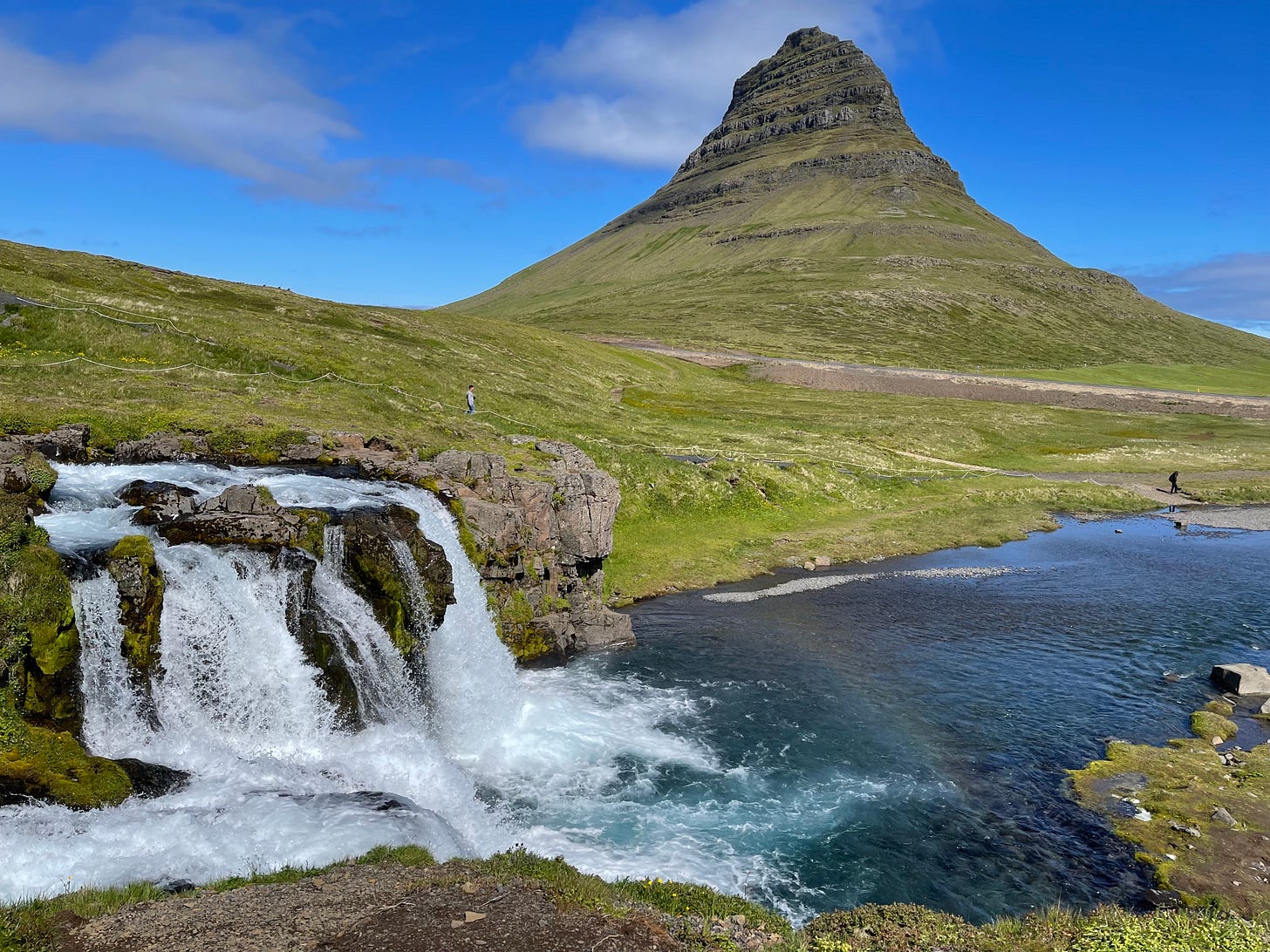



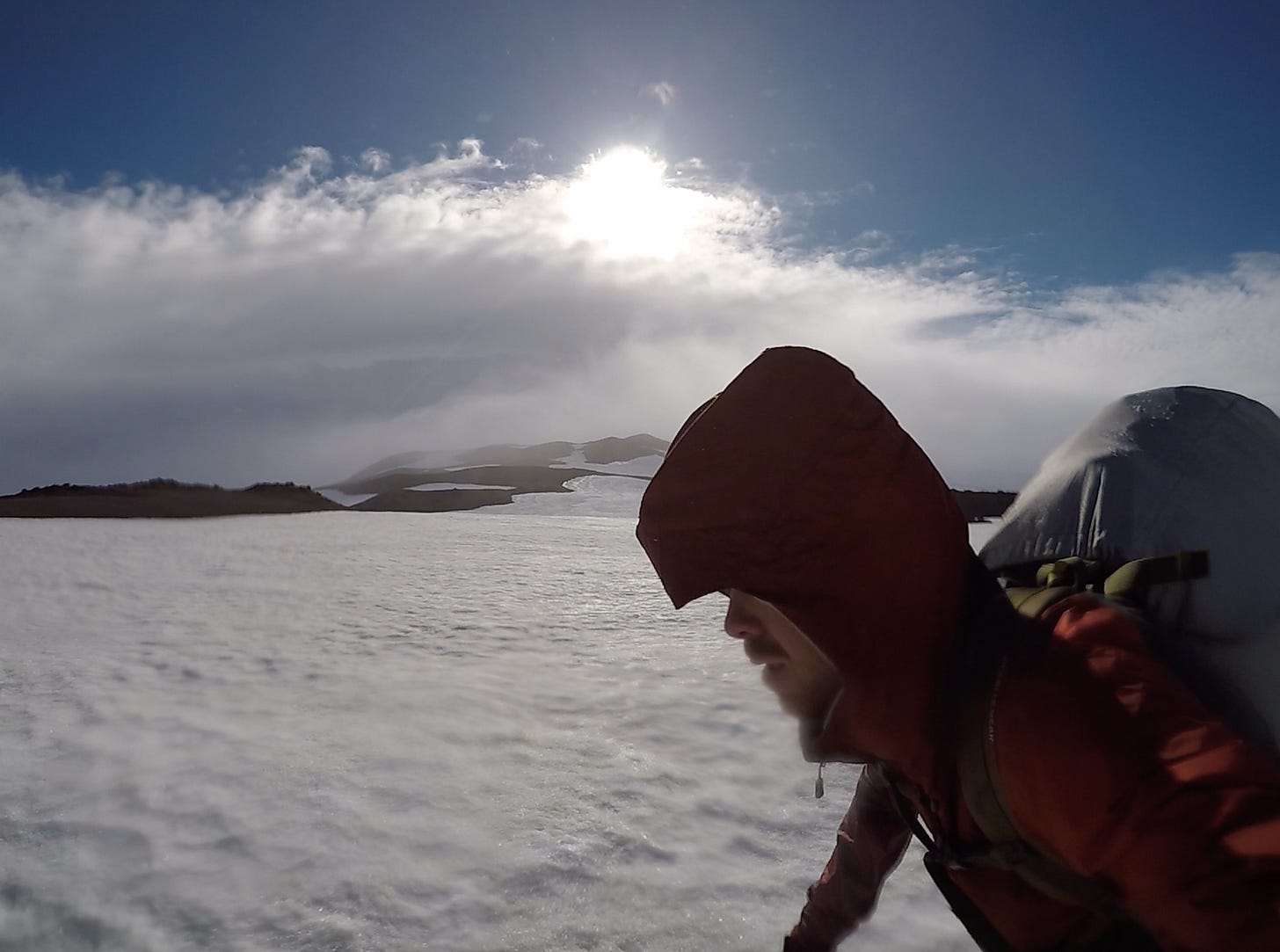
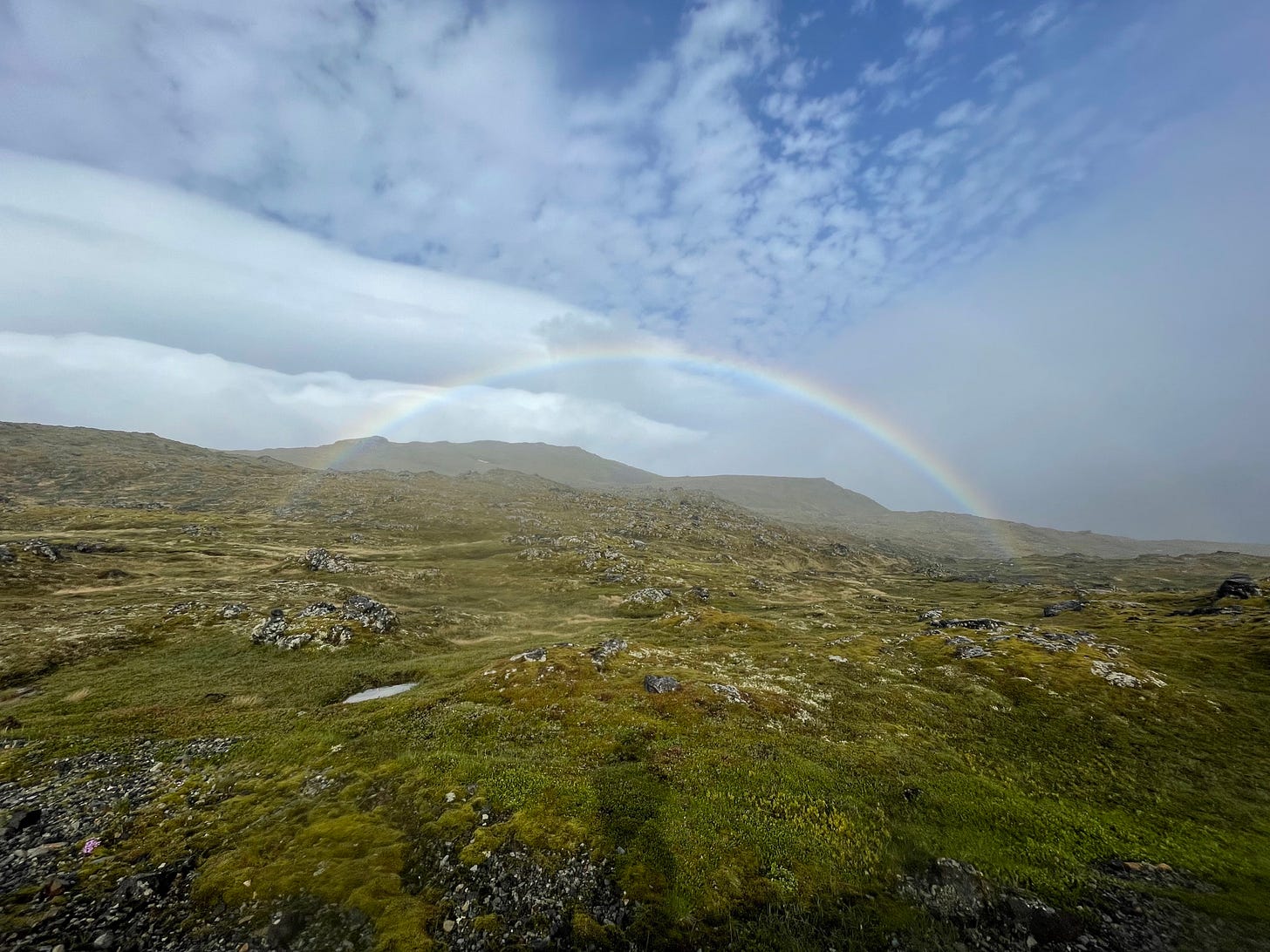

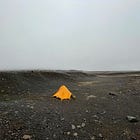
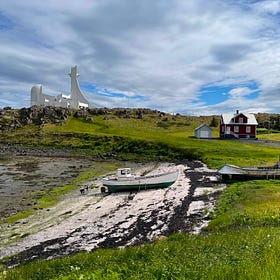
Wow such beautiful scenery and beautiful writing Garrett! "It's a feeling of overwhelming bliss and joy and gratitude paired with a sense of insignificance. It seems like a paradox, but it's simply the duality of majesty and mortality; etymologically, this means feeling "the greatness of God" while acknowledging that I am "subject to death.""
I've always felt a bit deflated by this sense of insignificance sometimes, and like you, those feelings come up when faced with the vastness of earth, when i look over majestic gigantic landscapes - how do you find joy and liberation in it?
I also recently re-read the beginning of infinity by David Deutsch, where he talks about our how our cosmic insignificance may be overplayed... and that as creatures that can create knowledge about the universe, we are pivotal players in it. What do you think of that idea?
Great writing, wonderful to follow your story. Yes indeed what a joy it is to feel so insignificant and yet so unique and important all at the same time. It gives us a better perspective on our journey, it brings us into the present moment wide awake and it gives us a better ability to remain open minded with our fellow conscious human beings. Great last line btw "I am wholly insignificant on the scale of the Universe yet holy and significant on the scale of myself." perfection!